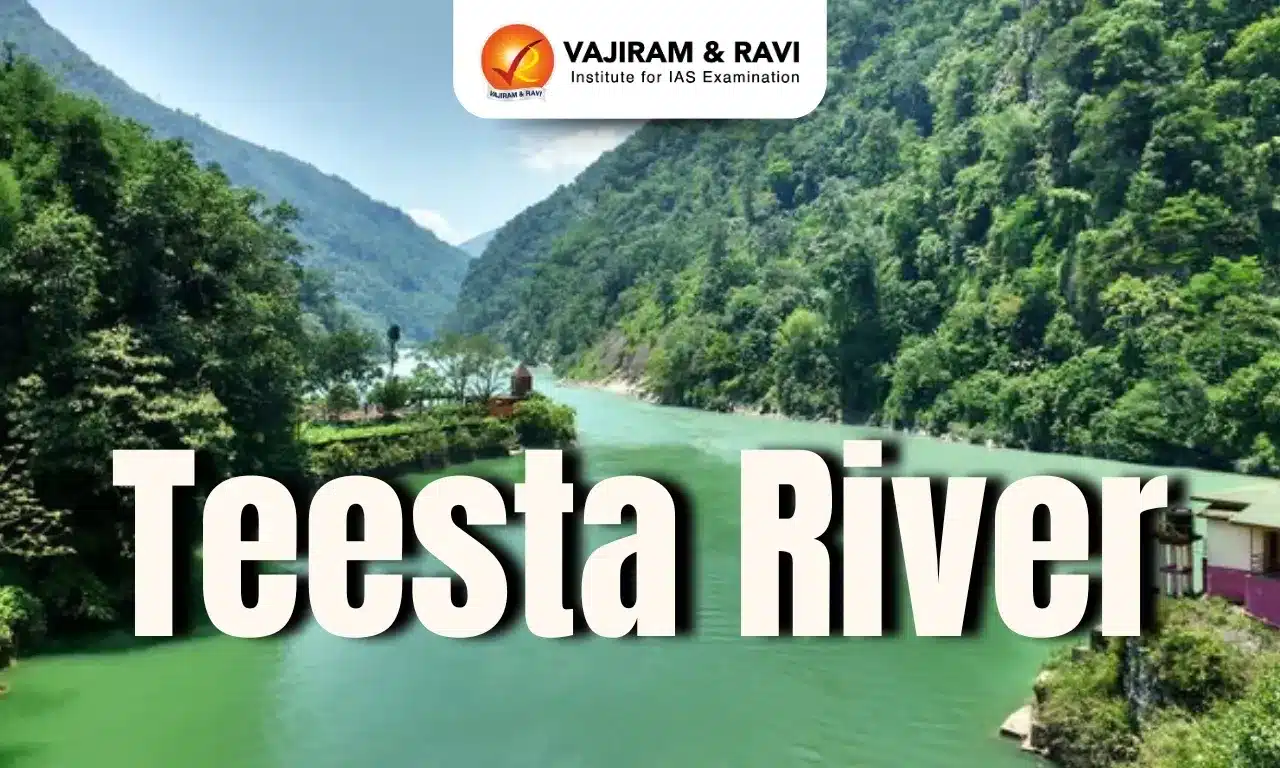Teesta River Latest News
Recently, Bangladesh welcomed Chinese participation in the Teesta River Comprehensive Management and Restoration Project.
About the Teesta River
- Geographical significance: The Teesta River is a major transboundary river flowing through India and Bangladesh, serving as a crucial water resource for both nations.
- Origin: The river originates from the Tso Lhamo Lake at an elevation of approximately 5,280 meters in North Sikkim, India.
- Other sources cited include the Pahunri Glacier, Khangse Glacier, and Chho Lhamo Lake.
- Course: The Teesta flows southward through the Sikkim Himalayas, passing towns like Rangpo, and then through West Bengal before entering Bangladesh, where it joins the Brahmaputra River (known as the Jamuna River in Bangladesh).
- Historically, the Teesta was a major tributary of the Ganges River.
- Length and basin area: The river spans approximately 414 kilometers, with a drainage basin covering around 12,540 square kilometers. Notably, 83% of the basin lies in India, while 17% is in Bangladesh.
- Tributaries:
- Left-bank tributaries: Lachung Chhu, Chakung Chhu, Dik Chhu, Rani Khola, and Rangpo Chhu.
- Right-bank tributaries: Zemu Chhu, Rangyong Chhu, and Rangit River.
- Hydroelectric projects and barrages:
- In India:
- Teesta-V Dam: 510 MW, located in Gangtok district, Sikkim.
- Teesta-III Dam: 1,200 MW, situated in Mangan district, Sikkim.
- Teesta Low Dam III & IV: 132 MW and 160 MW respectively, both in Kalimpong district, West Bengal.
- Gajoldoba Barrage: Primarily for irrigation purposes in West Bengal.
- In Bangladesh:
- Duani Barrage: Used mainly for irrigation.
- Barakhata Teesta Barrage: Another significant irrigation infrastructure.
- In India:
Teesta River FAQs
Q1. Where does the Teesta River originate?
Ans. The Teesta River originates from the Tso Lhamo Lake in Sikkim and flows through West Bengal and Bangladesh before merging with the Brahmaputra.
Q2. What is the Teesta River water-sharing dispute?
Ans. India and Bangladesh have an ongoing dispute over Teesta’s water distribution, with Bangladesh seeking a fair share, while West Bengal expresses concerns over water availability.
Q3. What is the ecological significance of the Teesta River?
Ans. The river supports rich biodiversity, agriculture, and hydropower projects, but glacial retreat and human activities threaten its flow.
Source: TH
Last updated on December, 2025
→ Check out the latest UPSC Syllabus 2026 here.
→ Join Vajiram & Ravi’s Interview Guidance Programme for expert help to crack your final UPSC stage.
→ UPSC Mains Result 2025 is now out.
→ UPSC Notification 2026 is scheduled to be released on January 14, 2026.
→ UPSC Calendar 2026 is released on 15th May, 2025.
→ The UPSC Vacancy 2025 were released 1129, out of which 979 were for UPSC CSE and remaining 150 are for UPSC IFoS.
→ UPSC Prelims 2026 will be conducted on 24th May, 2026 & UPSC Mains 2026 will be conducted on 21st August 2026.
→ The UPSC Selection Process is of 3 stages-Prelims, Mains and Interview.
→ UPSC Result 2024 is released with latest UPSC Marksheet 2024. Check Now!
→ UPSC Prelims Result 2025 is out now for the CSE held on 25 May 2025.
→ UPSC Toppers List 2024 is released now. Shakti Dubey is UPSC AIR 1 2024 Topper.
→ UPSC Prelims Question Paper 2025 and Unofficial Prelims Answer Key 2025 are available now.
→ UPSC Mains Question Paper 2025 is out for Essay, GS 1, 2, 3 & GS 4.
→ UPSC Mains Indian Language Question Paper 2025 is now out.
→ UPSC Mains Optional Question Paper 2025 is now out.
→ Also check Best IAS Coaching in Delhi

















